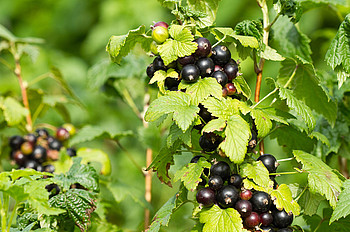Origin of the blackcurrant

The botanical name of the blackcurrant is Ribes nigrum and the plant belongs to the gooseberry family. Depending on the region, it is also known as eelberry, black currant or cassis. The home of the small berry is the climatically temperate zones of Europe and Asia, but today it is found almost everywhere in the world. The thornless shrub grows up to two metres high and is a popular garden plant in Germany. You can recognise blackcurrants by their heart-shaped leaves with hairy undersides and an intense smell - this distinguishes them from red and white varieties of the berry. Inconspicuous flowers appear in late spring, from which the fruits, about eight millimetres in size, emerge a few weeks later.
Cultivation and harvesting of blackcurrants
Unlike most fruit varieties, the blackcurrant has been growing in Germany for thousands of years - even the Germanic tribes are said to have cultivated the blackcurrant. In wild form, the plant is mainly found in moist locations near forests. It likes nutrient-rich, loamy soils and prefers a sunny position with little wind. Most plants bear fruit for the first time when they are one or two years old, and these grow as clusters on the bush. The best harvest time for blackcurrants in Central Europe is between June and August. When fully ripe, the berries have an intense black-red colour and can be easily detached from the panicle.
Blackcurrants and their ingredients
Lemons still have the reputation of containing a particularly high amount of vitamin C. The blackcurrant, however, has about three times as much. Just 100 grams of berries cover the daily requirement of vitamin C - and that with only about 40 kilocalories. This makes the small black fruit a local alternative to the vitamin C-rich acerola. Just like the berries of the black elderberry, blackcurrants contain anthocyanins - flavonoids that are responsible for the dark colour of the fruit.
Use and processing
Fresh currants spoil quickly and should therefore be processed quickly after harvesting. Blackcurrants have a stronger and more tart taste than their white and red relatives. Sweeter fruits, such as raspberries or strawberries, are therefore an ideal complement to the tart taste of blackcurrants. Due to its fine acidity, the black berry also tastes delicious in processed form, for example as
- Blackcurrent nectar
- Syrup
- Compote
- Jelly or jam
If you would like to benefit from the valuable ingredients of blackcurrants but do not have fresh berries to hand, we recommend consuming them in the form of a high-quality pure juice from first pressing. During the gentle production of our Blackcurrant juice from Rabenhorst, the fruits are only pressed once so that the abundance of natural ingredients is preserved.
FAQ
What is the difference between black, red and white currants?
Although all currants belong to the same family, the species differ in terms of taste, appearance and ingredients. The black berries are slightly larger than their lighter relatives and contain more vitamin C and colour-giving anthocyanins.
Can you eat blackcurrants raw?
You can eat fresh currants straight from the bush with a clear conscience. However, as the taste can be a little tart and sour, many people prefer to eat them in the form of jam, jelly or juice.
Do blackcurrants contain a lot of vitamin C?
Blackcurrants have a high vitamin C content. A daily portion of 100 ml of our high-quality "Blackcurrant" pure juice from first pressing contains 80 mg of vitamin C and thus covers 100 % of the reference amount (NRV) of vitamin C recommended for an adult according to the European Union.

